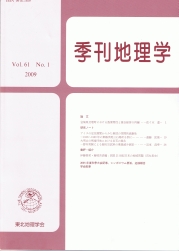
- Issue 4 Pages 159-
- Issue 3 Pages 95-
- Issue 2 Pages 57-
- Issue 1 Pages 1-
- |<
- <
- 1
- >
- >|
-
Ryo SHIMIZU, Tomoki NAKAYA, Tomoya HANIBUCHI, Yuzuru ISODAArticle type: Original Article
2022Volume 74Issue 4 Pages 159-178
Published: 2022
Released on J-STAGE: November 30, 2022
JOURNAL FREE ACCESSRecently, various neighborhood indicators have been used to examine geographical variations in the perceptions and behaviors of urban residents in relation to the physical forms of their neighborhoods.However, the characteristics of a streetscape as a comprehensive neighborhood environment, which can only be determined by combining such indicators, have not been examined. Therefore, in this study, neighborhoods in the Sendai metropolitan area, Japan, were classified based on several urban morphological indicators to obtain a typology of Japanese residential areas in terms of the neighborhood physical environment. It was then confirmed that the various subjective evaluations of residential areas obtained from the social survey data differed significantly between the area typologies, which was also observed when controlling for individual attributes. The results revealed that the physical form of the neighborhood is associated with neighborhood liveability;in particular, a type found around city centers distinguished from other areas by its high density, connectivity, and accessibility is strongly associated with positive evaluations of the area in most aspects.
View full abstractDownload PDF (2148K)
-
Yuna YOKOYAMA, Tomoya HANIBUCHI, Yuzuru ISODA, Shigeki MATSUDA, Tomoki ...Article type: Short Report
2022Volume 74Issue 4 Pages 179-188
Published: 2022
Released on J-STAGE: November 30, 2022
JOURNAL FREE ACCESS
-
2022Volume 74Issue 4 Pages 189-190
Published: 2022
Released on J-STAGE: November 30, 2022
JOURNAL FREE ACCESSDownload PDF (279K)
-
2022Volume 74Issue 4 Pages 191
Published: 2022
Released on J-STAGE: November 30, 2022
JOURNAL FREE ACCESSDownload PDF (74K)
-
Article type: Erratum
2022Volume 74Issue 4 Pages 192
Published: 2022
Released on J-STAGE: November 30, 2022
JOURNAL FREE ACCESSDownload PDF (39K)
- |<
- <
- 1
- >
- >|